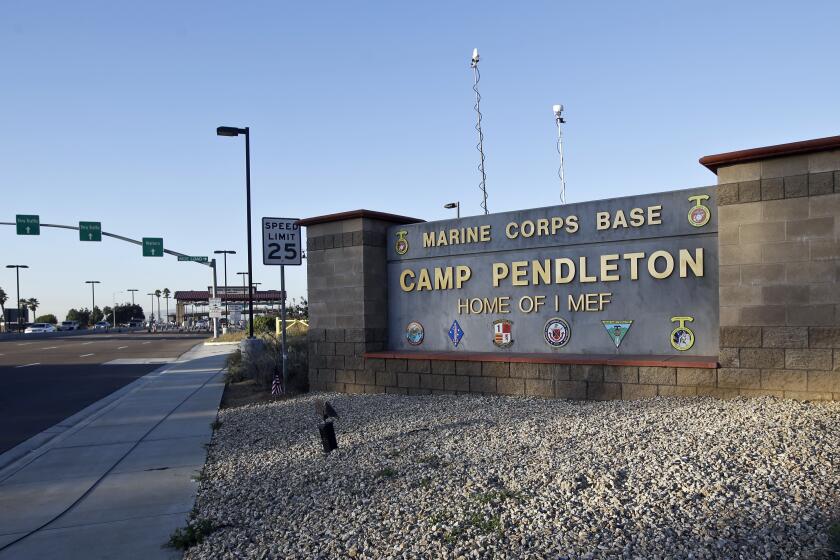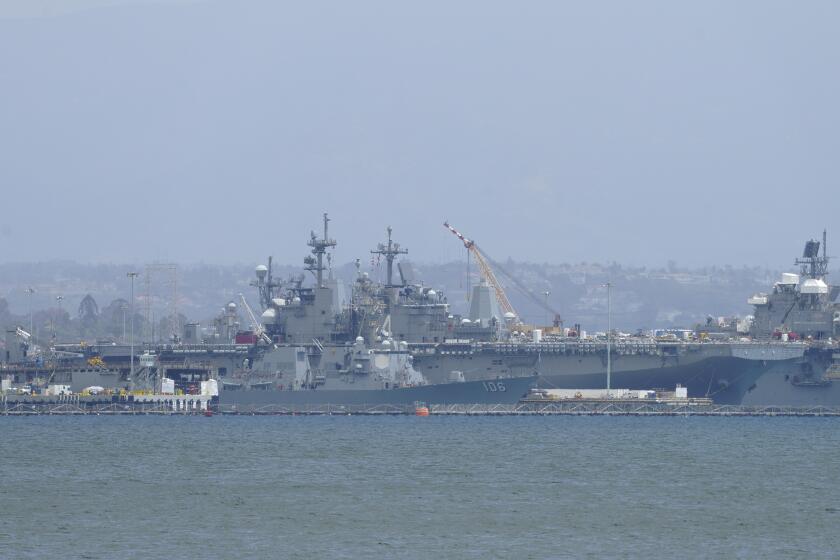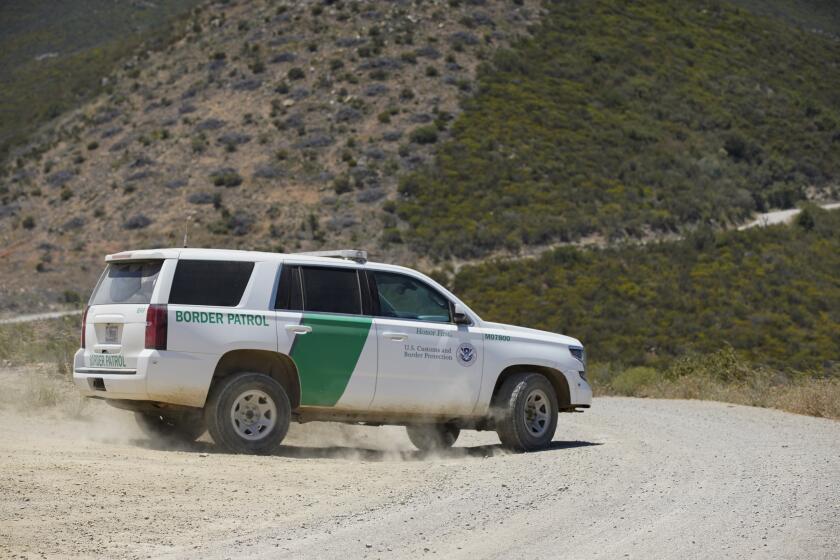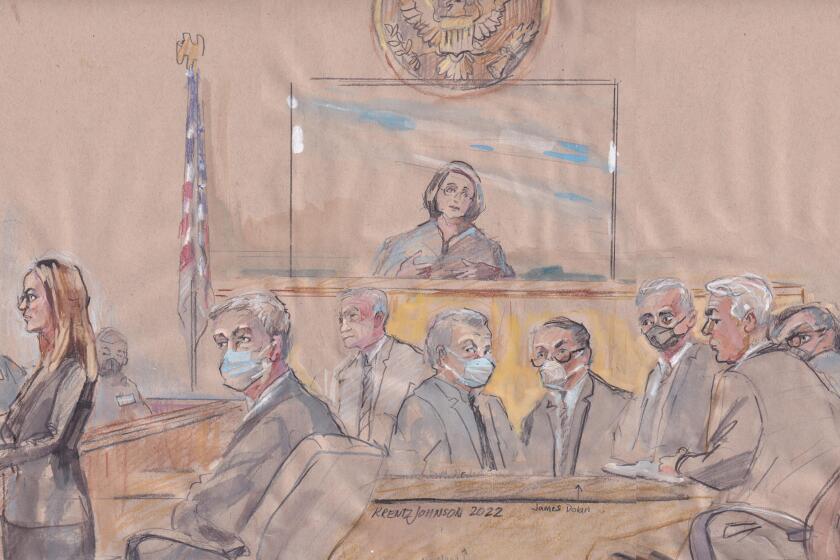U.S.-Philippine alliance sails on choppy waters
The plan announced recently to re-open a former U.S. naval base on the South China Sea was a complicated one for the Philippines, where a rip current of anxiety over Chinese militarization of the disputed waters is churning up national pride, economic concerns and debate over reinvigorated ties to American forces.
The Philippines kicked the U.S. military out of the country in 1992, refusing to extend a lease with its former colonial overlord for Subic Bay and several other major bases. But the Manila government has been steadily backtracking on its anti-American snub ever since.
In the mid ‘90s, a rising China quickly capitalized on the power vacuum in the South China Sea by occupying Mischief Reef over protests from the Philippines. American naval vessels soon returned to Filipino waters for repairs, fuel and joint military exercises around Subic Bay, which was converted into a freeport zone with tax concessions for economic investment.
Last year, as China’s island-building campaign and construction of military-grade fortifications on reefs of disputed ownership went into overdrive, the Philippines signed an enhanced defense agreement with the U.S. to allow a rotational force of American troops ashore.
Then in July, the Philippine defense department announced a plan to re-open Subic Bay to military activity by stationing its ships and aircraft at the massive former installation, which is one of eight bases in the Philippines where the U.S. also hopes to deploy forces.
Conflicted feelings among Filipinos, many of whom have relatives living in the U.S. and Chinese ancestry, are stalling the growing military alliance. The new defense agreement, for example, is hung up by a legal challenge under review by the Supreme Court.
The 1987 Constitution prohibits permanent U.S. bases in the Philippines without a treaty. The defense agreement rules out such a plan, but an anti-American “fringe” is trying to block what it views as a fire sale allowing for defacto Yankee bases, according to observers in the Philippines.
Relations between the two countries, although cooperative and positive today, remain complex, said Aileen San Pablo-Baviera, a professor of China studies and international relations at the University of the Philippines.
“It’s important to understand history. From the Philippine side, right now it is perhaps one of the strongest alliances with the United States. But before it was an alliance, it was a relationship characterized by enmity and conflict, a colonial relationship. Very asymmetrical, with subjugation.
“Attempts by the United States to pacify the Philippine insurrection during the colonial period still shape the nature of nationalism in the Philippines today,” she said.
Crosscurrents of that history are displayed in the lobby of the National Defense College of the Philippines on Camp Aguinaldo, the base outside Manila that serves as headquarters for the Philippine armed forces.
A massive mural of the Balangiga massacre of U.S. soldiers in 1901 during the Philippine-American War hangs in the entry, near smaller tributes to the Great Wall of China and rebellion by Chinese residents against Spanish rule.
Near the stairwell is a photo of the former U.S. Coast Guard cutter Dallas transferred in 2012 to the Philippines — one of two re-commissioned as frigates that are flagships of its nascent navy.
Many Filipino officers train in the U.S., such as Rear Adm. Caesar Taccad. The 54-year-old surface warfare officer served at Coronado in 1988 and obtained a master’s degree in 1998 from the Naval Postgraduate School in Monterey. “We’ve been friends much earlier. Equals, a little later,” Taccad said with a smile.
In light of renewed tensions in the South China Sea and Chinese efforts to seal off areas it claims, “We see the U.S. as a primary player to protect the commons from those who would restrict others,” said Brig. Gen. Guillermo Molina, deputy commander of Western Command. That Philippine command oversees the South China Sea, which the Philippine Congress renamed the “West Philippine Sea” a few years ago.
“Our country’s sovereignty over the West Philippine Sea is now our biggest security concern,” Molina said. “Thus more than ever it is imperative to transition the armed forces from internal security towards external, territorial control as rapidly as possible.”
As the Philippines embarks on a military modernization campaign, which includes a recent request for a 25 percent increase in defense spending, some sniff that the U.S. isn’t doing enough.
“We have been getting scrap from the United States that is almost incongruous to what we actually need... Everybody can help and we should not be dependent on the United States,” said Roilo Golez, former chairman of the House Committee on National Defense.
The Philippines had its first joint naval exercise with Japan recently and it is courting arms sales from other countries, even as many push for conciliation with China. “China is not an enemy. China is a friend with whom we have a serious problem,” said Evan Garcia, undersecretary for policy in the Department of Foreign Affairs.
Walden Bello, who resigned from Congress this year in protest over the president’s handling of a botched military operation against Islamist insurgents, said the Philippines is getting shortchanged by the new defense agreement: “The Philippines will give the United States the right to offer its bases for low rent, without the guarantee of U.S. protection defending its island territories.”
He worries that being a “hand-maiden” of U.S. foreign policy will drag the Philippines into open conflict with China. “None of the key players want war,” he said, but “the problem is that in a situation of fierce rivalry among powers, an incident, intended or unintended, may trigger an uncontrollable chain of events that may result in a regional war, or worse.”
A U.S. government official in Manila said America’s presence has a stabilizing effect and strengthened security agreements are mutually beneficial: “We seek a peaceful Asia-Pacific region where all states, and I mean all of them, enjoy the benefits of security and continue to prosper.”
Residents of cities and villages around Subic Bay are among the most vocal about wanting the Americans back, largely for economic reasons.
In Masinloc, where depleted fish stocks in the South China Sea make for thin margins, some fishing boats are grounded. After the Chinese coast guard started using water cannons to evict Filipinos from the Scarborough Shoal, it became too difficult to profit, said Efren Forones, a 53-year-old who used to fish the shoal. “I hope everything will be resolved over the Scarborough Shoal so I can go back to fishing,” he said.
In Olongapo City, where a U.S. Marine is on trial now for the October 2014 murder of a transgender Filipino, the bars are empty of American troops who used to rack up tabs. The Ambyanz Night Life club where Pfc. Joseph Pemberton met Jennifer Laude is shuttered, across the street from the hotel where the body was found.
The case inspired protests about the ugly side of U.S. military intervention, including violence, prostitution and exploitation. It also triggered a strict new shore liberty policy by U.S. Pacific Command that hurt local businessmen.
The number of U.S. military personnel sailing into Subic Bay had jumped in recent years, from 16,112 in 2013 to 28,014 last year. Those visitors pumped an estimated $4.5 million into the local economy in 2015, local authorities said.
Bong Pineda, 67, a hotel investor and former president of the Olongapo Chamber of Commerce, is among those pining for the Americans. He grew up with them — his father was employed at the U.S. naval base.
“If the Americans didn’t leave, there would be no problem in the South China Sea,” he said.
Gretel C. Kovach reported this story as a Jefferson Fellow with the Honolulu-based East-West Center during a tour of China, the Philippines, Singapore and Hawaii.
Get Essential San Diego, weekday mornings
Get top headlines from the Union-Tribune in your inbox weekday mornings, including top news, local, sports, business, entertainment and opinion.
You may occasionally receive promotional content from the San Diego Union-Tribune.





